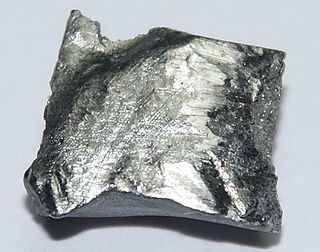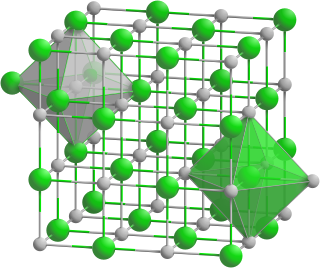Related Research Articles

Terbium is a chemical element; it has the symbol Tb and atomic number 65. It is a silvery-white, rare earth metal that is malleable, and ductile. The ninth member of the lanthanide series, terbium is a fairly electropositive metal that reacts with water, evolving hydrogen gas. Terbium is never found in nature as a free element, but it is contained in many minerals, including cerite, gadolinite, monazite, xenotime and euxenite.

Zinc nitride (Zn3N2) is an inorganic compound of zinc and nitrogen, usually obtained as (blue)grey crystals. It is a semiconductor. In pure form, it has the anti-bixbyite structure.

Hafnium carbide (HfC) is a chemical compound of hafnium and carbon. Previously the material was estimated to have a melting point of about 3,900 °C. More recent tests have been able to conclusively prove that the substance has an even higher melting point of 3,958 °C exceeding those of tantalum carbide and tantalum hafnium carbide which were both previously estimated to be higher. However, it has a low oxidation resistance, with the oxidation starting at temperatures as low as 430 °C. Experimental testing in 2018 confirmed the higher melting point yielding a result of 3,982 (±30°C) with a small possibility that the melting point may even exceed 4,000°C.

Terbium(III) bromide (TbBr3) is a crystalline chemical compound.

Terbium(III) chloride (TbCl3) is a chemical compound. In the solid state TbCl3 has the YCl3 layer structure. Terbium(III) chloride frequently forms a hexahydrate.
Terbium(III) iodide (TbI3) is an inorganic chemical compound.
Praseodymium(III) nitride is a binary inorganic compound of praseodymium and nitrogen. Its chemical formula is PrN. The compound forms black crystals, and reacts with water.

Terbium phosphide is an inorganic compound of terbium and phosphorus with the chemical formula TbP.
Praseodymium compounds are compounds formed by the lanthanide metal praseodymium (Pr). In these compounds, praseodymium generally exhibits the +3 oxidation state, such as PrCl3, Pr(NO3)3 and Pr(CH3COO)3. However, compounds with praseodymium in the +2 and +4 oxidation states, and unlike other lanthanides, the +5 oxidation state, are also known.

Terbium compounds are compounds formed by the lanthanide metal terbium (Tb). Terbium generally exhibits the +3 oxidation state in these compounds, such as in TbCl3, Tb(NO3)3 and Tb(CH3COO)3. Compounds with terbium in the +4 oxidation state are also known, such as TbO2 and BaTbF6. Terbium can also form compounds in the 0, +1 and +2 oxidation states.
Terbium perchlorate is an inorganic compound having chemical formula Tb(ClO4)3. This salt of terbium(III) can be obtained by reacting terbium(III,IV) oxide with perchloric acid. The perchlorates are non-coordinating anions, so this substance can be used as a starting material for forming Tb(III) complexes. For example, reaction with alanine forms a complex in which the carboxylate portion of four alanine units bridge between two terbium atoms. It can be used to synthesize terbium-containing metal-organic framework materials.
Holmium nitride is a binary inorganic compound of holmium and nitrogen with the chemical formula HoN.

Dypsrosium nitride is a binary inorganic compound of dysprosium and nitride with the chemical formula DyN.

Plutonium nitride is a binary inorganic compound of plutonium and nitrogen with the chemical formula PuN.
Neptunium nitride is a binary inorganic compound of neptunium and nitrogen with the chemical formula NpN.
Gadolinium(III) nitride is a binary inorganic compound of gadolinium and nitrogen with the chemical formula GdN.
Lanthanum nitride is a binary inorganic compound of lanthanum and nitride with the chemical formula LaN.
Protactinium nitride is a binary inorganic compound of protactinium and nitrogen with the chemical formula PaN.
Lutetium nitride is a binary inorganic compound of lutetium and nitrogen with the chemical formula LuN.
Lanthanide compounds are compounds formed by the 15 elements classed as lanthanides. The lanthanides are generally trivalent, although some, such as cerium and europium, are capable of forming compounds in other oxidation states.
References
- ↑ "Terbium Nitride". American Elements . Retrieved 9 February 2024.
- ↑ "TbN Powder / Terbium Nitride Powder 20um 99.9%". us-nano.com. Retrieved 9 February 2024.
- ↑ Perry, Dale L. (19 April 2016). Handbook of Inorganic Compounds. CRC Press. ISBN 978-1-4398-1462-8 . Retrieved 9 February 2024.
- ↑ "mp-2117: TbN (cubic, Fm-3m, 225)". Materials Project . Retrieved 9 February 2024.
- ↑ Yi, Gyu-Chul (13 January 2012). Semiconductor Nanostructures for Optoelectronic Devices: Processing, Characterization and Applications. Springer Science & Business Media. p. 118. ISBN 978-3-642-22480-5 . Retrieved 10 February 2024.